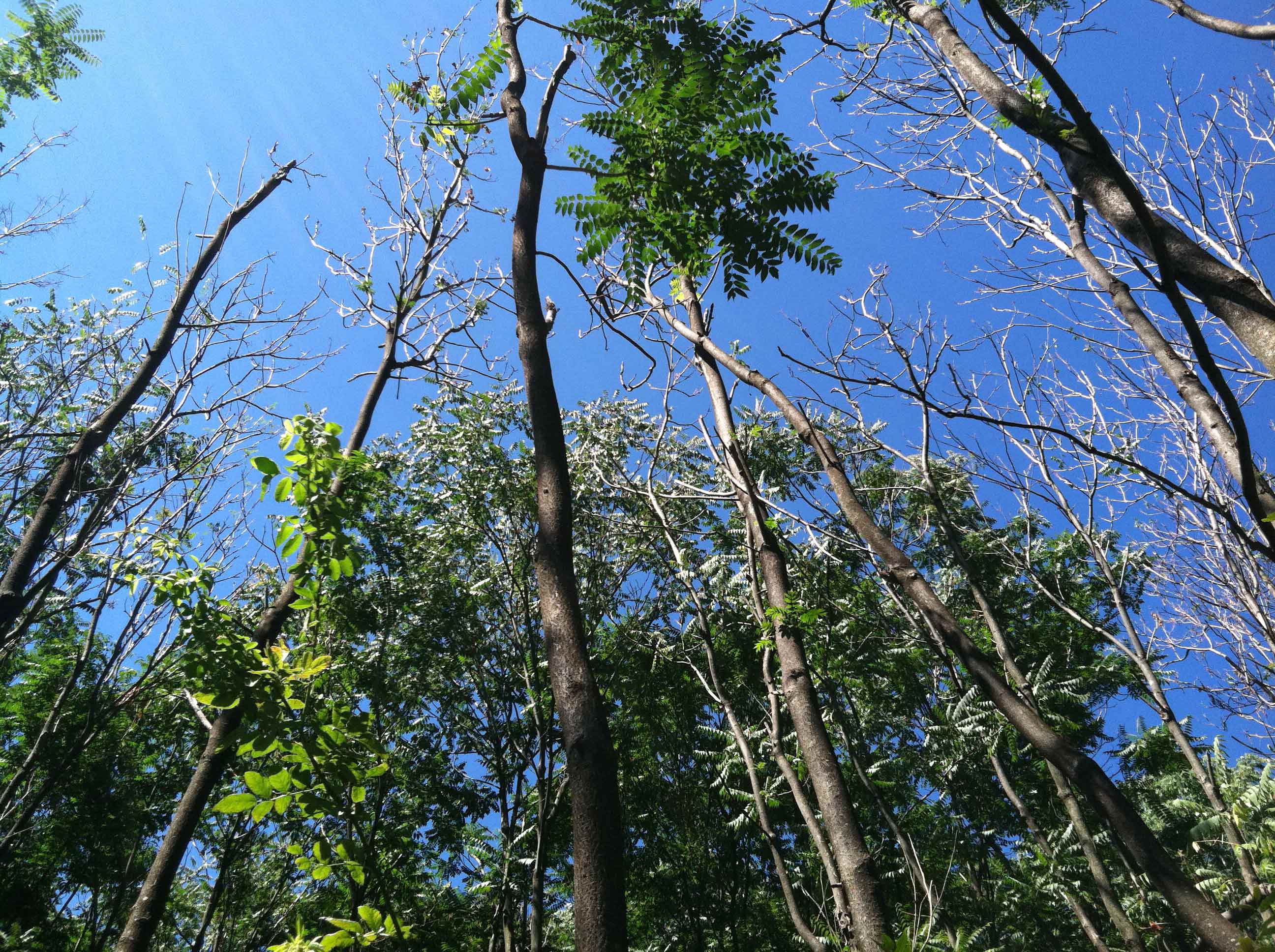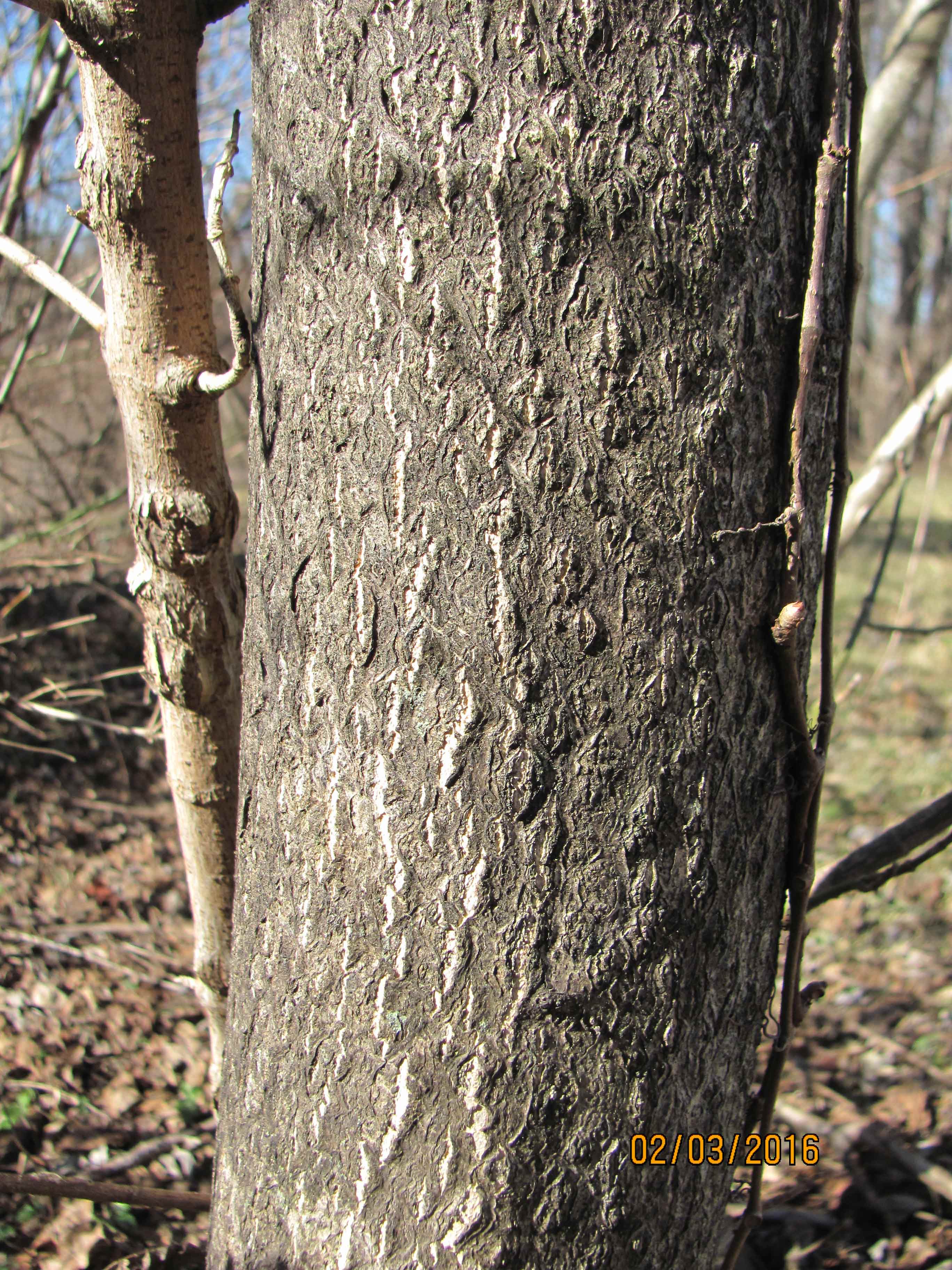A Native Soil-Borne Fungus Shows Promise in Controlling Ailanthus
By Joanne Rebbeck
Because the non-native Ailanthus tree (commonly referred to as tree-of-heaven) is a prolific sprouter, it is very challenging to control by mechanical and chemical means. Cutting down a single tree can result in a proliferation of fast-growing sprouts. Herbicide treatments are costly and require follow-up monitoring and retreatment. However, an alternative control method for Ailanthus is being tested in nearby Ohio. Dead and dying Ailanthus trees in Pennsylvania as a result of infection with the Verticillium fungus. Photo by Don Davis, Penn State University.
Dead and dying Ailanthus trees in Pennsylvania as a result of infection with the Verticillium fungus. Photo by Don Davis, Penn State University.
Penn State University Forest Pathologist, Don Davis, and graduate students identified a Verticillium wilt causing fungus as a potential biological control agent of Ailanthus. In 2002, they isolated Verticillium nonalfalfae from dead and dying Ailanthus trees within forested areas of south-central PA. After much rigorous testing and numerous trials in PA, this soil-borne fungus, V. nonalfalfae was found to be very specific and pathogenic to Ailanthus. Stem inoculations (a hack-n-squirt treatment) of Ailanthus seedlings with the isolate in the greenhouse and canopy trees in the field resulted in 100% mortality within 10-16 weeks. Stem inoculations of seedlings or canopy trees of the following tree species: northern red oak, chestnut oak, red maple, sugar maple, white ash and yellow-poplar did not induce wilt symptoms or mortality. Within forested areas of dead and dying Ailanthus trees, no non-Ailanthus trees exhibited any wilt symptoms.
Ongoing research continues to test other woody species as well as crop plants. The current list of tested non-susceptible species currently exceeds 70. The testing of staghorn sumac and devil’s walkingstick which have shown some limited susceptibility are currently underway. Since the fungus is native to North America, we are not introducing a new exotic organism. Once introduced into a stand, the fungus can spread from tree to tree through root grafting and naturally build up, so not every Ailanthus stem in a stand needs to be treated!
Since the fungus specifically kills Ailanthus and it can survive in the soil for many years, it has great potential as a biological herbicide. To date, the same fungus was found at multiple forest stands in Virginia and Ohio – an effort that required many informed sets of eyes out looking for large patches of wilting, dying and dead Ailanthus. Unfortunately due to federal quarantine regulations, we are not permitted to transport the fungus across state lines.
Efforts are currently underway to find the fungus in Indiana but we need your help! If you observe large areas of rapidly wilting and dying Ailanthus trees, please investigate further and contact me at jrebbeck@fs.fed.us. A downloadable factsheet showing symptom development is available at http://www.nrs.fs.fed.us/units/sustainingforests/local-resources/downloads/wilt_handout.pdf
If the Verticillium wilt is found in Indiana researchers may have the opportunity to provide answers that could lead to the reduction or elimination of this exotic invasive tree.
Here is an outline of the symptoms to be looking for next summer:
Rapid or sudden wilting foliage throughout the entire tree showing symptoms followed by defoliation as leaves die.
1. Check for signs of vascular discoloration by peeling away the bark. Infected vascular tissue will be an orange-brown color compared with a white to cream color tissue in healthy vascular
2. Large distinct areas of declining, dying, and dead trees. It is uncommon to find isolated single infected or dead trees. Tree death is rapid. Areas increase over time as infection spreads, typically through root-to-root transmission from infected to healthy trees. The fungus can persist in the soil for many years, which is typical of other Verticillium species.
Identifying Tree-of-Heaven (Ailanthus altissima)
Tree-of-heaven may be confused with similar-sized sumacs or even black walnut to the untrained eye. Because tree-of-heaven can grow very rapidly, they will often have several feet between branching along the main trunk. Some have also described the strong odor from tree-of-heaven similar to rotting peanuts. Others even think it should be renamed, “Stink Tree” – just crumble the leaves or break off a branch and smell.
 Figure 2. The fruit of tree-of-heaven are winged samaras. They can be green, red or brown in color. Numerous clusters of fruit are easily observed on tree-of-heaven during the summer. Tree-of-heaven have pinnately compound leaves with 11 to 27 leaflets. Each leaflet has one to several glandular teeth near the base. These are lacking on other trees and shrubs.
Figure 2. The fruit of tree-of-heaven are winged samaras. They can be green, red or brown in color. Numerous clusters of fruit are easily observed on tree-of-heaven during the summer. Tree-of-heaven have pinnately compound leaves with 11 to 27 leaflets. Each leaflet has one to several glandular teeth near the base. These are lacking on other trees and shrubs.
The leaflets and fruit are also good ways to identify them. Each leaflet has one or more glandular lobes or teeth near the base. This is the best feature to differentiate it from similar species of similar size. On older trees, numerous fruit clusters will begin to form towards the end of June and will be present throughout most of July or longer. Black walnuts and other native trees with compound leaves lack these seed clusters.
Dr. Joanne Rebbeck is a plant physiologist with the USDA Forest Service, Northern Research Station based in Delaware, Ohio.
